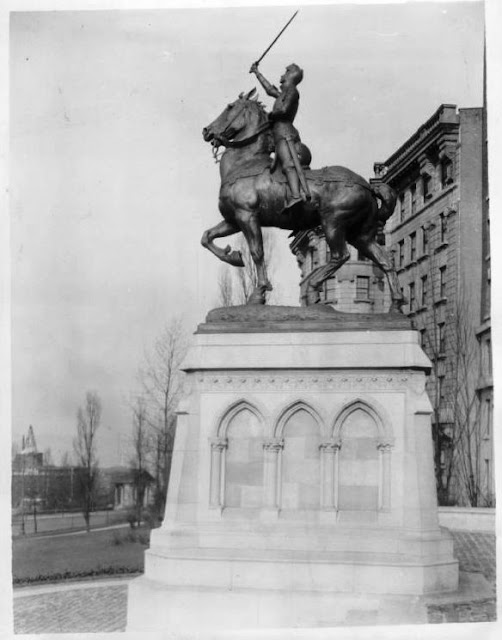 |
| photo dnainfo.com |
In 1909 Hyatt began work on her most ambitious work yet – a life-size plaster statue of Joan of Arc astride a muscular steed. Inspired by a flurry of interest in the life of the saint as the 500th anniversary of Joan's birth drew near, the artist endeavored to depict “the spiritual rather than the warlike point of view.” She placed the figure standing in the stirrups, sword raised toward Heaven, praying for guidance.
 |
| Hyatt's plaster sculpture -- photo NYPL Collection |
Anna Hyatt submitted the statue to celebrated Salon in Paris in 1910. The jury was so impressed with the quality of the work that it was quite certain that Hyatt had either had help or it was not her work at all – no woman could have executed such a skillful piece. She was, however, awarded an honorable mention.
Coincidentally, a committee of New Yorkers had been formed in 1909 to raise funds and erect a statue to Saint Joan and members traveled to Paris in search of a sculptor. Hyatt’s depiction, quite different than any others, attracted their attention.
Back home in New York they initiated a competition that resulted in world-wide submissions. Committee President Dr. George Frederick Kunz remarked “Our Committee has decided upon several things; one is that the statue must be artistic, and there will be no question as to whether the sculptor is American, Russian or Hottentot, nor does the committee care whether a man or a woman designs the statue. Upon one thing, however, we shall be insistent, that is, that the statue must be worthy of one of the greatest personalities that has ever lived, of one of the greatest of nations, France, to which it must also be a tribute, and to the coming greatest city in the world, New York.”
When some questioned the relevance of a statue to Saint Joan in New York, an art critic for Art and Archaeology magazine fired back “…wherever true valor is admired, wherever noble unselfish effort is respected, whenever loyalty and true courage and zeal and patriotism are esteemed, -- there ought to be a memorial to the Maid of Orleans.”
Committee member J. Sanford Saltus (who would eventually give $25,000 towards the statue and donate copies to Blois, France, the Cathedral of St. John the Divine, and the French cities of Domremy and Orleans), aggressively supported Hyatt’s design.
She won.
Huntington, a prominent art collector who been employed by Tiffany & Co., worked with Hyatt, refining and enlarging her prototype. The artist used her niece, Clara Hunter Hyatt, astride a barrel, as the model for Saint Joan and borrowed a horse from the nearby fire house.
To ensure authenticity, the Curator of Armor at the Metropolitan Museum of Art was consulted regarding the appropriate armor. Dr. George Frederick Kunz, President of the committee, subsequently remarked that “it is the belief of the committee who have the honor to erect the statue that it will be the first one ever created in which the armor worn by Joan of Arc is true to the period and therefore authentic, thus adding greatly to the interest and value of the figure.”
As remarkable as the 13-1/2 foot statue itself was the pedestal upon which it was placed. Designed by John Vredenburgh Van Pelt, the Gothic-styled base would be 6 feet high and 30 feet long. Constructed of Mohegan granite from quarries near Peeksill, New York, the panels within the Gothic arches were from the Chateau de Bouvreuil in Rouen where Joan of Arc was imprisoned. One cylindrical stone from the Cathedral of Rheims, acquired after a World War I bombardment in 1915, was inserted as part of the base after the statue’s dedication. (The Cathedral was the site of the coronation of Charles VII through the efforts of Joan of Arc.)
A small copper box was placed inside the base containing a letters from President Woodrow Wilson to George Kunz; a letter from the governor of New York, Charles Whitman; one from the vicar of Rheims Cathedral and from the Cardinal of New York; several French and American coins, bronze medals and plaques; and a “fairy stone” that symbolized the tears of Saint Joan.
 |
| The statue in 1929, before being surrounded by trees -- postcard from author's collection |
The statue, erected at Riverside Drive and 93rd Street, was dedicated with great ceremony on December 6, 1915. With its unveiling by Mrs. Thomas Edison, the reputation of Anna Hyatt as a prominent artist was assured. The 1917 issue of Art and Archaeology magazine, published by The Archaeological Institute of America, gushed with accolades.
“Indeed too much can not be spoken in praise of it. In the opinion of many competent critics it is by far the finest equestrian statue in New York, unsurpassed by the Siegel of Bitter, the Grant of Partridge, the Slocum of MacMonnies, the Sherman of Saint Gaudens, by Shrady’s ‘Valley Forge’ horse in the Williamsburg Bridge Plaza, or even the Washington by Ward in Union Square.”
The magazine went on to say “France is thronged with statues of the Maid of Orleans, but none of them surpasses this splendid masterpiece of sculpture.”
Anna Hyatt was awarded the Rosette of Public Instruction by the French Ambassador and, in 1922, appointed Chevalier of the Legion of Honor. Throughout the 20th century the statue was the destination of every French dignitary that visited New York and the site of repeated memorials and celebrations.
In 1939 the monument received its first restoration. The sword was repaired, the bronze recoated and the stone staircase to restored. Another restoration occurred in the spring of 1987 when the Grand Marnier Foundation used a $34,500 grant to clean and repair the statue.
Although often overlooked, Anna Vaughn Hyatt’s heroic statue of Joan of Arc is one of the outstanding public sculptures in Manhattan.
.png)

No comments:
Post a Comment